Aboriginal Art in the USA
This article traces the emergence of Australian Aboriginal art as major focus in the American art scene.
Aboriginal art has moved at some point from being an ethnographic study to being a contemporary art form with international appeal.
Some of the turning points are found in the USA, starting with the Dreamings exhibition held in New York in 1988. Other American collectors had already made an impact with their collecting of earlier art and artefacts. A new pathway opened up when the Desert art movement started to spread from the small settlement of Papunya in 1971. This coincided with the arrival of larger canvases that expressed in an abstract or symbolic way, the spiritual concepts behind Aboriginal desert culture.
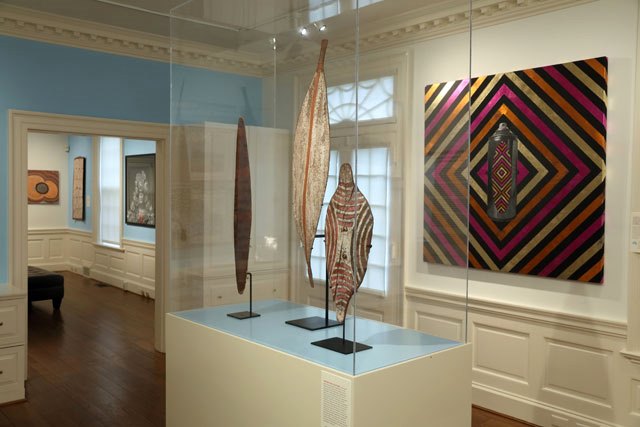
Dreamings: The Art of Aboriginal Australia, at the Asia Society in New York, November 1988
The New York Times published an article titled Dreamscapes on 13 November 1988 written by Australian author Thomas Keneally. He writes ‘in the last 20 years, Aboriginal artists have won a new and zealous audience and begun to invade the galleries. A major exhibition, ''Dreamings: The Art of Aboriginal Australia,'' opened at the Asia Society in New York City last month and will remain there until 31 December 1988 when it travels to the David and Alfred Smart Gallery of the University of Chicago. Anyone who sees the show's 100 or so sculptures, paintings on bark and contemporary acrylics on canvas will accept easily that they are serious and sophisticated business.’
Keneally gave context to this significant exhibition by major Aboriginal artists, setting up the profile for a wider audience appreciation of the artworks created in the 1970s and 1980s.
Kenneally states ‘It's obvious when you talk to these desert people, whether in outstations or in settlements, that they consider this majestic but ferocious land a series of great splendours and bounties provided by the Dreaming ancestors.’
‘There are areas of such paintings that the artists will tell you a lot about; others are closed. I am always aware that Aborigines can display the strong Australian tendency toward persiflage, or what, if an American were doing it, would be called a snow job. Nonetheless, it is true that if you're discussing a painting with one of the artists in a gallery and point to a particular feature apparently no different from another, you'll be told, ''He's secret, that feller.''
‘Aboriginal artists show no urge to hang their paintings on the walls of their homes. The major impact of a work, after all, is in the making of it. The design is eternal, and each artist has it firmly in mind. It informs the way he or she looks at the world, but it has no place ''on display'' in the Western sense of the words. If Westerners want to pay for and hang the work, that's fine. For the Dreaming, the artist, too, paid, often through painful and terrifying initiations.
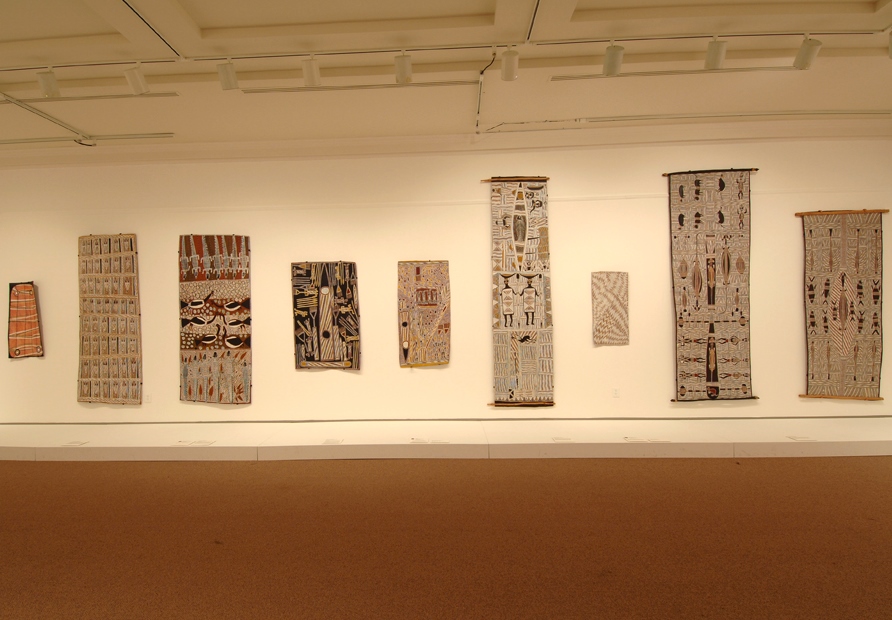
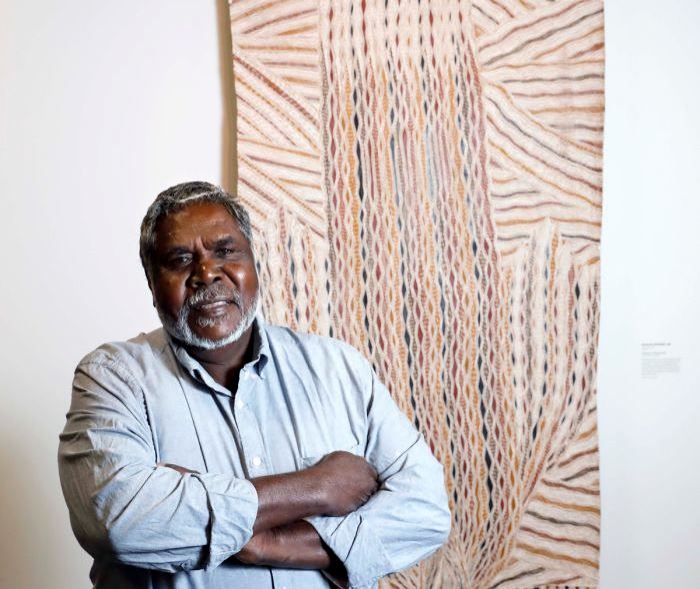
Art of Australia 1788-1941, Touring Exhibition
American reception of Aboriginal art has a significant track record that saw Aboriginal art showcased in the USA at least as strongly as in Australian cities. The grandly named Great American Exploring Expedition of 1838-1842 collected work from Port Jackson and displayed it in Washington DC for a decade.
Later the ‘Art of Australia 1788-1941’ was a touring exhibition funded by the Carnegie Corporation that opened in 1941 in the National Gallery of Art in Washington DC. Dr Kira Randolph presented the PhD paper titled ‘Australian Aboriginal art in the United States of America 1941-1966’ at the University of Melbourne, arguing that American collectors perceived Aboriginal art as a contemporary art form before the notion had gained currency in Australia.
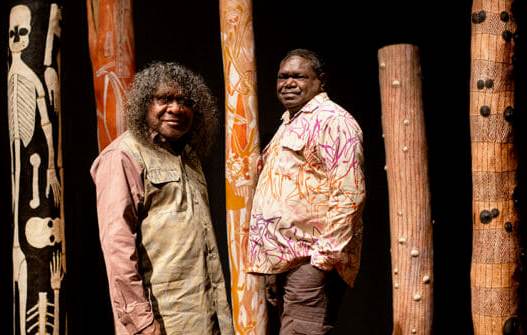
The Kluge-Ruhe Aboriginal Art Collection, University of Virginia
The Kluge-Ruhe Aboriginal Art Collection at the University of Virginia in Charlottesville is the only museum in the United States that is dedicated to Indigenous Australian art and the only museum outside Australia that has this mission. It aims is to bring global recognition of Aboriginal art and culture and to share an appreciation of human diversity and creativity. The museum runs exhibitions, artist residencies and interactive events to bring visitors closer to the art and to better understand the culture.
In February 2020 Charlottesville hosted six separate Aboriginal art exhibitions in the town of 50,000 people. At the UNESCO heritage Site listed the University of Virginia, the Kluge-Ruhe Collection has nearly 2000 Aboriginal artworks, a major world collection by any standard.

Beyond Dreamings: Three Decades of Indigenous Australian Art in the USA
The Kluge-Ruhe Aboriginal Art Collection at the University of Virginia in Charlottesville is the only museum in the United States that is dedicated to Indigenous Australian art and the only museum outside Australia that has this mission. It aims is to bring global recognition of Aboriginal art and culture and to share an appreciation of human diversity and creativity. The museum runs exhibitions, artist residencies and interactive events to bring visitors closer to the art and to better understand the culture.
In February 2020 Charlottesville hosted six separate Aboriginal art exhibitions in the town of 50,000 people. At the UNESCO heritage Site listed the University of Virginia, the Kluge-Ruhe Collection has nearly 2000 Aboriginal artworks, a major world collection by any standard.
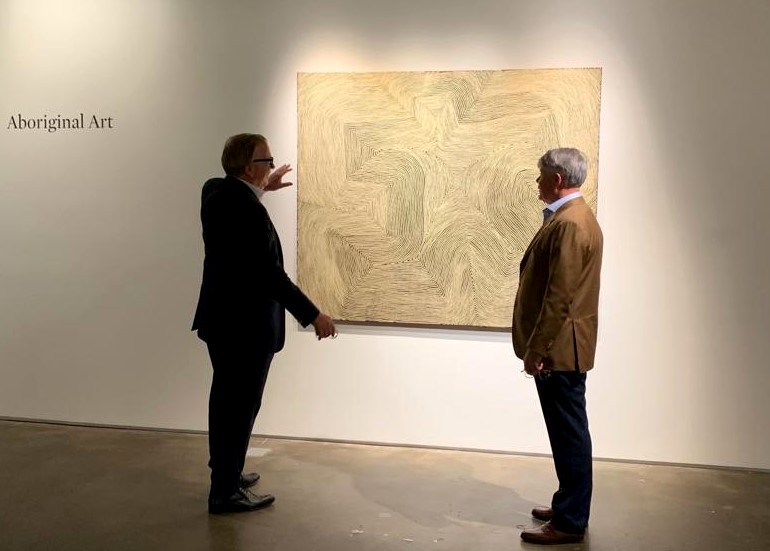
Of Country and Culture: The Lam Collection of Contemporary Australian Aboriginal Art
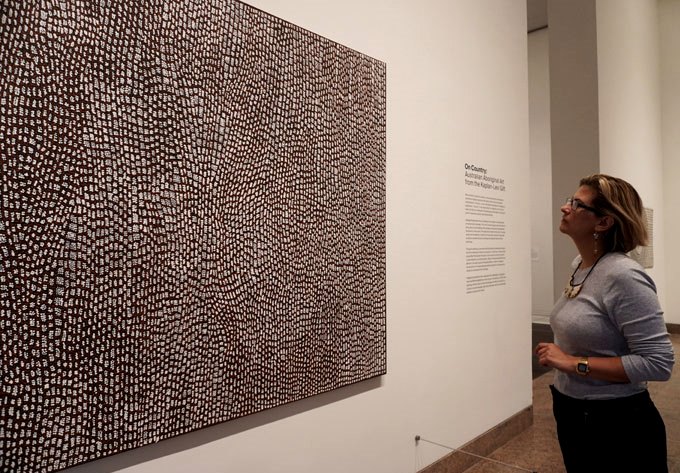
Collections of Dennis and Debra Scholl
The Indigenous works from around Australia draw on thousands of years of history — except with a contemporary twist. Director Dorothy Kosinski confirmed her own observation "that contemporary art is not just a Western phenomenon. I have the sense that for many of our visitors this will be a voyage of discovery and it will prick their imagination and set them off on journeys they never expected," she said. The exhibition titled ‘Marking the Infinite: Contemporary Women Artists from Aboriginal Australia’ engaged nine living artists to contribute works that involved weaving, sculpture, ceremonial objects and painting.
Dennis and Debra Scholl have made major donations from their Aboriginal art collection into US institutions, with a total of 200 works going to the Frost Museum in Miami, The Metropolitan Museum of Art and the Nevarda Museum of Art.
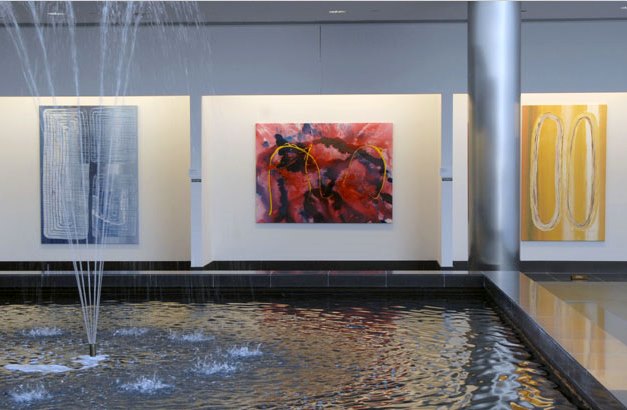
The Rise of Aboriginal Art Market in the USA
In September 2019 online art publisher Artsy ran an article titled ‘ What's Driving the Rise of Aboriginal Art Market in the U.S.’ Focusing on the Gagosian Gallery exhibition ‘Desert Painters of Australia’ held in New York, they note that actor and collector Steve Martin had loaned major works for the show. This followed on by the notice that Sotheby's was holding their first standalone Aboriginal art auction in the US in December 2019. Sotheby's had run such auctions for over twenty years in Australia and in London, so this new venture showed the growth in confidence of the US market and for collectors interested in artworks from outside the Western tradition.
Collectors Dennis and Debra Scholl had one of the major collections with over 400 Aboriginal artworks and had hosted three large public exhibitions – ‘No Boundaries’, ‘Marking the Infinite’ and ‘The Inside World’. Margo Smith, director of the Kluge-Ruhe Aboriginal Art Collection says of Aboriginal art ‘It has everything that you want in great contemporary art. In terms of the aesthetics, and also a great meaning, a great relationship to people and place and history.’ This is being reinforced by other international art institutions like the Tate Modern who are raising resources and commitment for their Aboriginal art collections.
The New York Times ran an article on 17 May 2019 by Jason Farago titled ‘Can We Start Appreciating Indigenous Art in its Own Terms?’ In considering the Gagosian exhibition ‘Desert Painters of Australia’ the writer asks of the wider US experience ‘can we stop pigeonholing contemporary Indigenous art as a critique or an exception to the settler mainstream and start appreciating it on its own terms.’ Comparison is made between the Indigenous populations of Australia at 3.3% and the USA about half that percentage, and the role of that indigenous artists play in their nation’s story.
Describing the symbols and coding of the Australian desert paintings, Farago says that ‘highly aware that these paintings circulate in white-dominated spaces, they do not depict ritual knowledge with legible forms, but rather layer, abbreviate, distend and obfuscate these forms into patterns that are neither properly “abstract” nor exactly representational.’
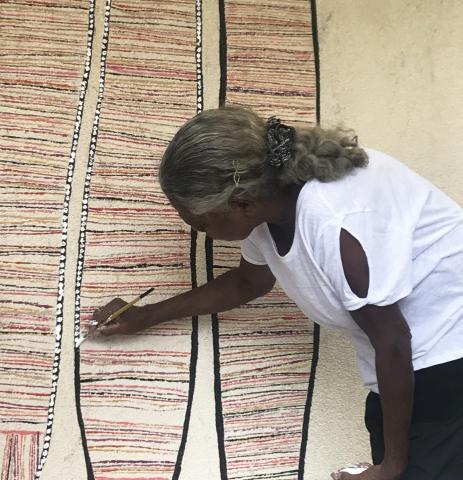
Japingka Galley View of the US Market
Last year was a watershed year in the development of the American Aboriginal art market because of the influence of some high profile collectors.
There has been spasmodic interest from American collectors over the years. Agents, representing individual artists, have been going across to the States visiting one or two towns or arranging small exhibitions. These have mainly been held in places like San Diego, California and very occasionally, New York.
This is why you will find pockets of interest and awareness scattered across the United States. We have seen a pattern of American visitors coming into Japingka Gallery recalling a one-off exhibition that sparked their interest in Aboriginal art.
What we have observed is that it is a struggle to reach that critical mass where a significant percentage of the American art buying public are aware of the unique nature of Aboriginal art.
The U.S. has the potential to be an enormous market because we know once people become aware of Australian Indigenous art, they usually love it.
Our American collectors tell us that there is like nothing else like it. They find it exciting, different and colourful. It tells a story, which is what they really love. It is not just a design exercise. They are also taken by the story telling from this ancient culture. From all of this we can see that once people see the art, it has great appeal for them.
The internet has helped facilitate communication with the American market. However, it is still a challenge to reach the specific target market within middle-class America.
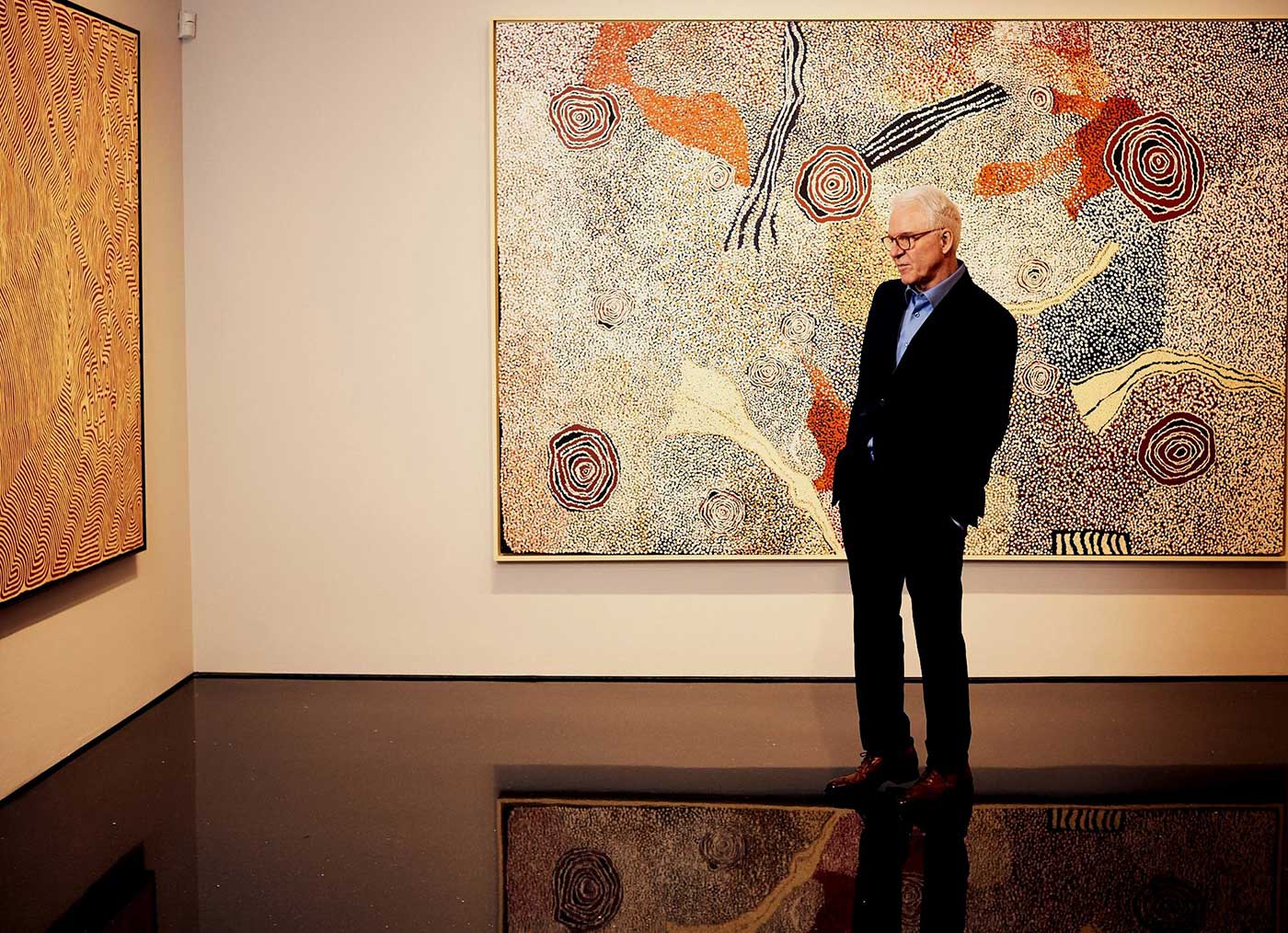
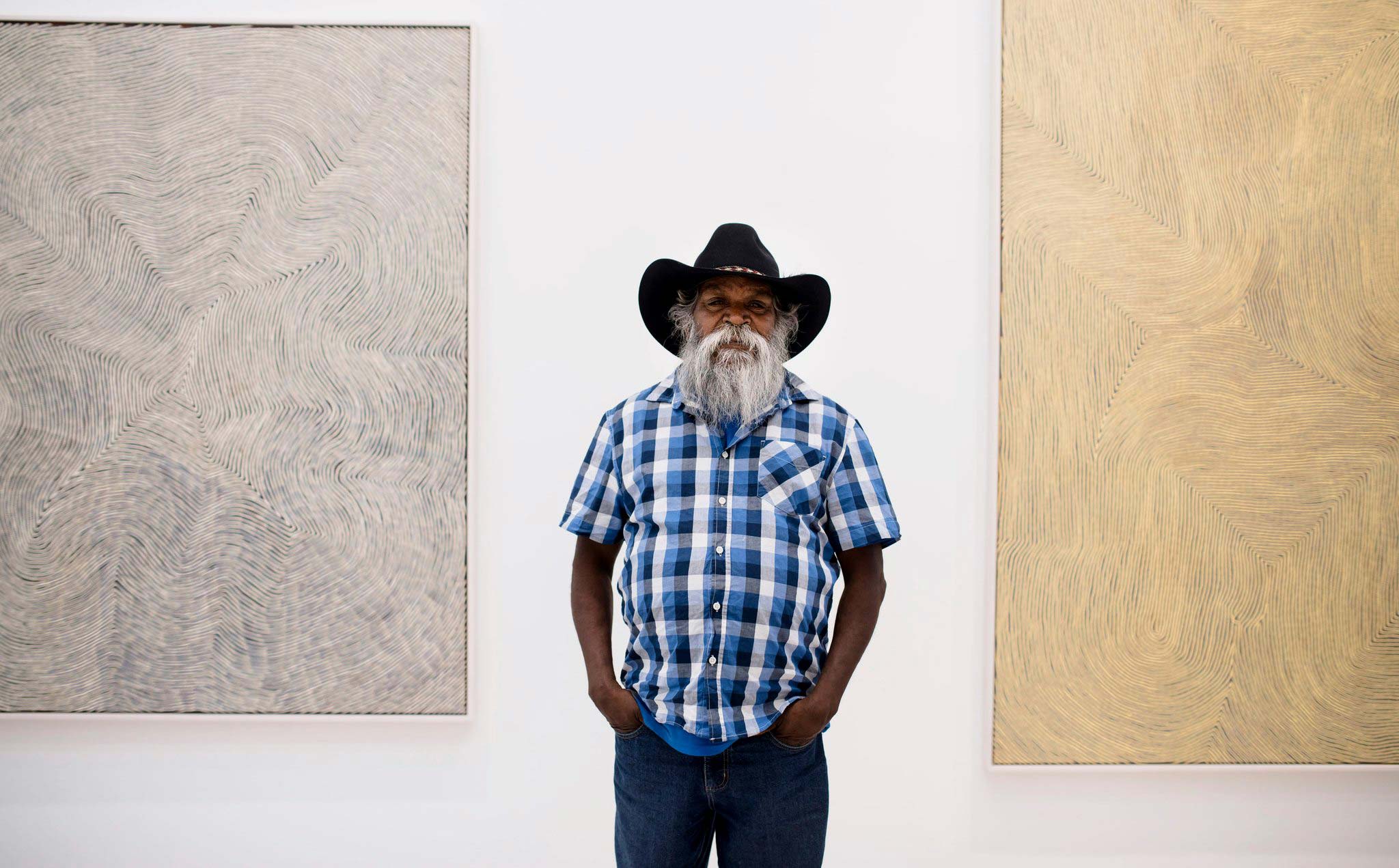
One of the biggest changes came about because New York galleries, like the Gagosian, mounted major exhibitions of Aboriginal art. They started to exhibit Aboriginal art as fine art rather than ethnic art.
Another driving force has been the major collectors like the Kluge-Ruhe Foundation who have been steadily collecting over several years. Still, these influences were not enough to capture the attention of the general population.
The cut through that was really needed was star power. Finally, this came happened when the comedian Steve Martin became known as a very serious collector of Indigenous art. He has been buying Aboriginal art from all around Australia for a few years.
A major high profile exhibition of Steve Martins's collection was held in New York in 2019. This was a critical turning point when a broader public started to become more aware of Aboriginal art as something interesting and desirable.
It's like that little snowball at the top of the Hill. It's starting to gather pace and mass, but it still has a long way to go. If this trend continues it could totally transform the Australian Indigenous art market, because the demand from the States could be enormous.
This is an exciting time and we know from over thirty years experience, once people get introduced the art and actually get a chance to have somebody explain to them, you've usually got a convert for life. We've got people around the world who are strong supporters of Aboriginal art and culture just because they've had someone explain key concepts to them.
Something we've noticed about the American collectors is that want to buy from someone who knows what they're talking about. This is because a lot of these people are fresh to it. They don't have the background history that a lot of Australians have on Indigenous culture and the meanings behind it.
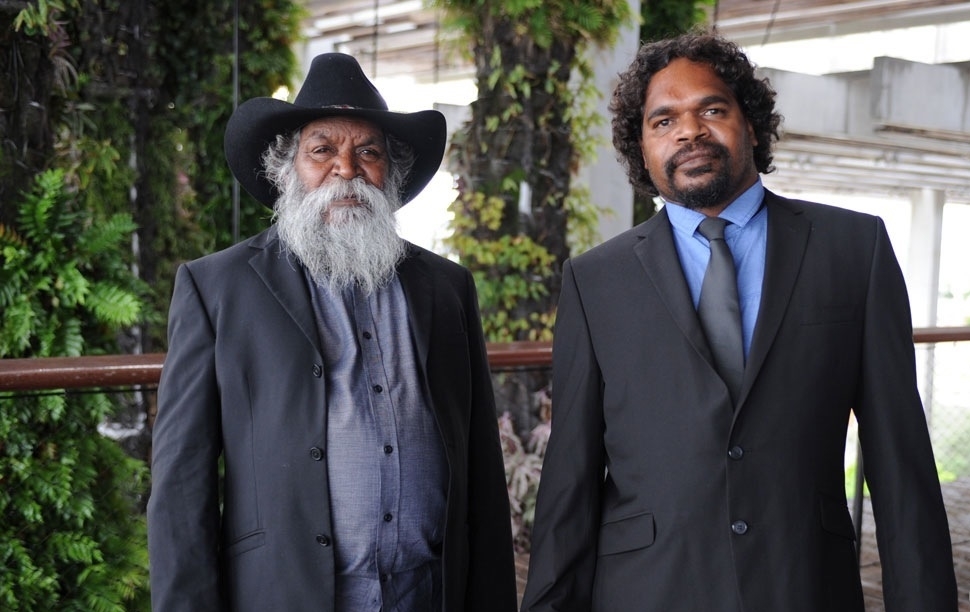
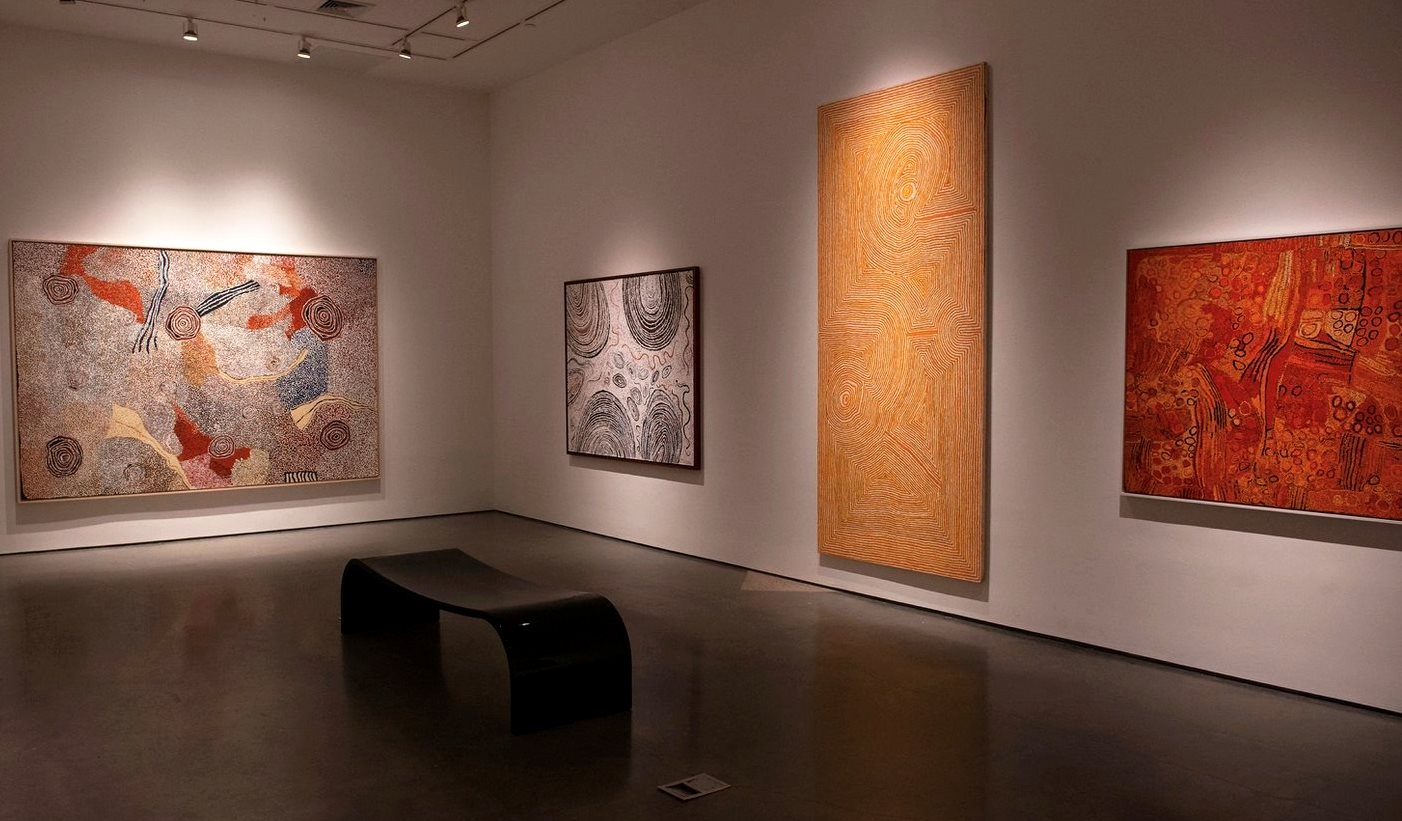
These American buyers have just come to it really as abstract art. They've seen it, they like it. They don't know necessarily why, but once it's explained to them that most of these paintings are maps or geographical, and even metaphysical depictions of country and the stories that happened there, it transforms their understanding of the painting. It just adds another layers to their enjoyment and appreciation.
Americans we meet who are travelling here are keen to learn more about Aboriginal art and they're intrigued. Once they find out the background story behind it, they are fascinated.
Most American visitors to our gallery want to own Aboriginal art and take a piece home with them. They especially want to have the story behind it and the information about the culture and the artist.
Until quite recently, we had assumed that most galleries supplied thorough documentation. Recently we met a major American collector who has been collecting for quite a few years. He told us he'd never encountered our level of documentation. He actually asked if we had special funding to prepare it.
We were a bit surprised and disappointed that some Australian Aboriginal art is still being sold with minimal documentation. We feel that people are missing out when they don't get the chance to fully understand the background to a work. Our standard level of documentation comes with every painting we sell, whether it be a painting for $150 or $20,000, the level of documentation is the same.
We supply a full story behind the painting and the artist as well as the history of their community. You get a certificate of provenance which details where the painting was sourced from. This is a paper trail that documents the whole history of the painting. We believe this information is critical.
It is our privilege to share our knowledge with the wider world. We want everyone to know what we know because it adds a deeper level to your appreciation and knowledge of why this art is so remarkable. Even after thirty years, we are still excited when works arrive for an exhibition. There are still so many surprises as different artists take fresh approaches to tell ancient stories.
Contemporary Aboriginal art is still evolving and we feel proud and excited to be able to share it with the emerging American market.
